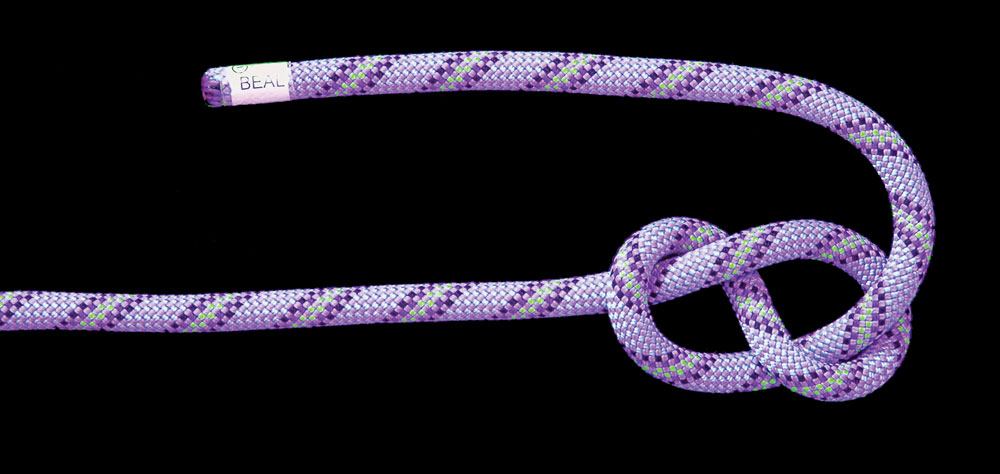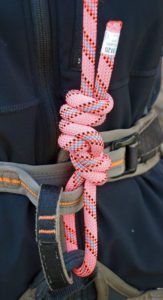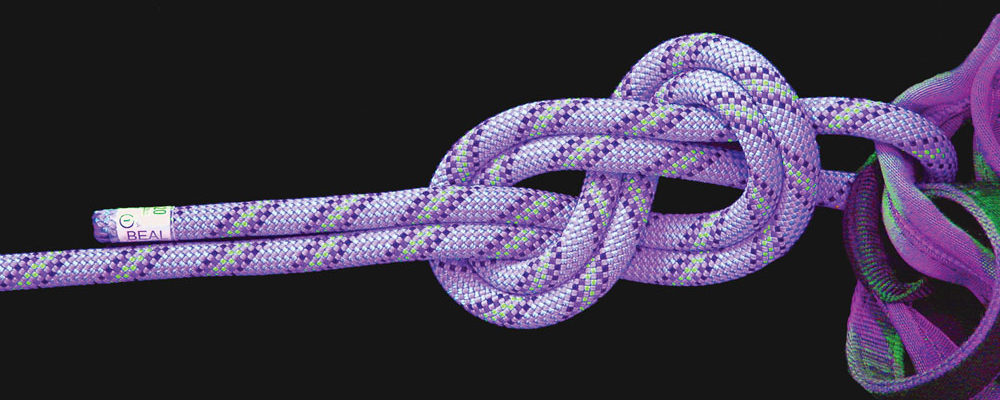This is an essential knot, and it can be tied in a number of ways. It is the main method that many people use when tying on to a harness, and when tied slightly differently it is a quick and effective method of tying on to anchors.
Its simplest form is a basic figure of eight, tied on a bight, or loop, of the rope. It is often used when tying a loop in the end of the rope, and this will subsequently be used to attach the rope to a harness with either one or two screwgate karabiners. This method of connection is frequently seen being used by climbers who are lowering from a sport route, after rigging the rope appropriately at the lower-off point. It is also used in a bottom rope situation, but should never, however, be used by anyone leading a climb, as the connecting karabiners introduce a weak and vulnerable link into the safety chain, with the possibility of cross-loading and a huge reduction in their rated strength in the event of a fall.
The rewoven version is a very good way to tie on to a harness, and it has the added advantage of being a recognizable shape when fully tied, useful when checking the attachment of others. Once the knot is completed, the loop created by the rope needs to end up roughly the same size as the abseil loop on the harness. If your harness does not have an abseil loop, making the rope loop just under fist size will be about right.

Starting the figure-of-eight rewoven
Once the figure of eight is completed, secure the end with a stopper knot, the best being half a double fisherman’s knot. This is to ensure that there is no way that the figure of eight can loosen whilst you are climbing or belaying. The tail left over when the stopper knot is completed should be about 5cm (2in) long.
Another version, the figure of eight on the bight, is ideal for use when constructing belays, and it is relevant for all rock, snow and ice situations. A huge advantage of this knot, apart from the ease with which it can be tied, is that if it is shock-loaded it will tighten within itself and absorb part of the load, thus reducing a percentage of the force transmitted through the anchor system holding a fall, especially that of a leader.
When you tie the knot, start with a bight of around 60cm (24in) and pass it through the tie-in loop of your harness. This means that when the knot is completed the tail that is left over will be around 30cm (12in) in length, and this is important as it ensures that the knot does not loosen and undo. Once the knot is complete, pull all four sections of rope to make it snug.
A final version is the double figure of eight. This is also referred to as bunny’s ears, and can be used for connection on to two anchors if a sling is not being used to equalize them. This is because each loop can easily be lengthened independently of the other, allowing for varying distances between attachment points to be reached. It is also handy when rigging a bottom rope climbing session, as the knot is easy to undo after it has been loaded (see ‘Top and bottom roping’).

The knot tied onto a harness
If you are using it to equalize two sides of an anchor system, the knot should be tied loosely and each of the loops adjusted to the required length before the knot is finally pulled tight. Further adjustment is still possible if need be. It is important, however that both of the loops are clipped into with a karabiner, as there is a chance, if the loops are short, that one could pull through if the other is loaded.
Word and images: Pete Hill






